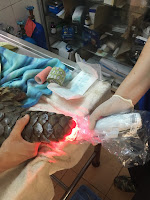Day 2
Day 2 was true conservation nursing. I was working alongside Huong, one of their vets providing treatment for the animals requiring it.
We looked through all of the items donated, talked about how they could be used and the wound benefits of each type of dressing. Although there are a lot of products available in Vietnam, some are not very good quality or just not available e.g. large surgical gloves, cohesive bandage. Their supply of bandaging materials had just run out so with a new stock we were going to be dressing some tail injuries and wounds. Aim 2 of my trip was achieved – ‘provide some useful materials and knowledge on their use in helping with wound healing’ (a big thanks to the companies who donated materials).
Throughout the morning the pangolins were each examined, clinical notes made and any required medication prescribed. The hand held light therapy machine (Photizo) was used on 6 individuals with wounds, each ranging from minor tail wounds to chronic open and infected wounds. All wounds were cleaned, debrided and dressings applied. A first for me was using a sanitary towel and tampon as a wound dressing!
I was putting my pangolin handling skills to the test. I did not appreciate how incredibly strong they were, and once they had hold of something with their tail they would not let go unless they wanted to!
By the time it was lunch time, I had earnt my food! Challenge of the day was learning to use chopsticks.
The afternoon involved taking a blood sample from an individual, using the ventral tail vein. This was a follow up sample on an individual with ongoing health issues. I processed the sample (WBC count, PCV, TS and WBC differential) in house using their lab equipment, a great resource and skill for them to have and be able to use in the middle of nowhere!
Something I hadn’t considered was how the 90% humidity would affect the equipment – the microscope lived in a box with bags of silicone gel beads for some protection.
For the rest afternoon, I looked through the clinical histories of some individuals and got familiar with the range of medications and equipment in the vet room. Being a veterinary nurse I also couldn’t help but clean and tidy as I went!
Dinner was with the rest of the volunteers in the restaurant, learning of their travels and how they ended up at Save Vietnam’s Wildlife. Using chopsticks- Mastered!
We looked through all of the items donated, talked about how they could be used and the wound benefits of each type of dressing. Although there are a lot of products available in Vietnam, some are not very good quality or just not available e.g. large surgical gloves, cohesive bandage. Their supply of bandaging materials had just run out so with a new stock we were going to be dressing some tail injuries and wounds. Aim 2 of my trip was achieved – ‘provide some useful materials and knowledge on their use in helping with wound healing’ (a big thanks to the companies who donated materials).
Throughout the morning the pangolins were each examined, clinical notes made and any required medication prescribed. The hand held light therapy machine (Photizo) was used on 6 individuals with wounds, each ranging from minor tail wounds to chronic open and infected wounds. All wounds were cleaned, debrided and dressings applied. A first for me was using a sanitary towel and tampon as a wound dressing!
I was putting my pangolin handling skills to the test. I did not appreciate how incredibly strong they were, and once they had hold of something with their tail they would not let go unless they wanted to!
By the time it was lunch time, I had earnt my food! Challenge of the day was learning to use chopsticks.
The afternoon involved taking a blood sample from an individual, using the ventral tail vein. This was a follow up sample on an individual with ongoing health issues. I processed the sample (WBC count, PCV, TS and WBC differential) in house using their lab equipment, a great resource and skill for them to have and be able to use in the middle of nowhere!
Something I hadn’t considered was how the 90% humidity would affect the equipment – the microscope lived in a box with bags of silicone gel beads for some protection.
Dinner was with the rest of the volunteers in the restaurant, learning of their travels and how they ended up at Save Vietnam’s Wildlife. Using chopsticks- Mastered!







Comments
Post a Comment